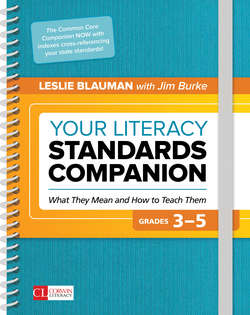Читать книгу Your Literacy Standards Companion, Grades 3-5 - Leslie Blauman - Страница 62
На сайте Литреса книга снята с продажи.
Common Core Reading Standard 5: What the Teacher Does
ОглавлениеTo teach students to refer to parts of stories, dramas, and poems and to describe how each successive part builds on earlier sections:
Read aloud, read aloud, read aloud—students’ minds are in a sense freed up to see the beauty of the structure, and how structure builds meaning, when they can hear the author’s language.
Explicitly teach elements of stories (beginning, middle, and end; chapters); dramas (scene, casts of characters, setting, descriptions, dialogue, stage directions); and poetry (stanza, verse, rhythm, meter).
Provide text sets for each genre so students will be familiar with them. Have specific sections of the classroom library for each.
Using the display screen or a shared text under the document camera, have students highlight a stanza, part of a scene, and so on, and explain how it builds on the previous one used.
Create flow charts or plot charts to show how successive parts build on earlier ones.
Have students work in small groups to look at a favorite text and pool understandings about its structure. Give them hints to look at first and last lines, first and last paragraphs.
Use a variety of story structure graphic organizers to help students understand how stories, poetry, and drama are organized.
Ensure that students read texts in all these genres during independent reading time.
To refer to the structural elements of poems and drama and to explain major differences between poems, drama, and prose:
